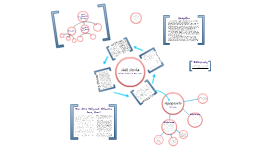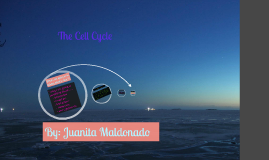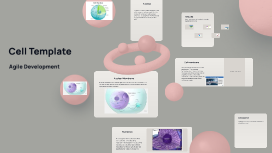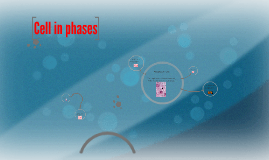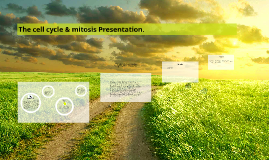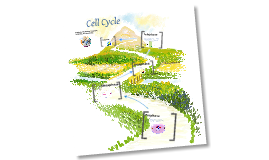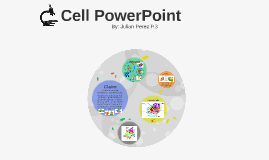Cell Cycle
Transcript: Please note that this Prezi contains only the topics specified in class, and not all of the steps of the phases of the Cell Cycle. Thank you. Cyclins are proteins that associate with cyclin-dependent protein kinases (CDKs) to regulate their activity and the progression of the cell cycle through specific checkpoints. Cyclin D, when it interacts with CDK4/6, and Cyclin E, when it interacts with CDK2, form two complexes with very important jobs. Cyclin D is produced when growth factors stimulate Raf/MEK/ERK. A signal is sent through a MAPK signaling complex which activates c-myc, which causes the transcription of Cyclin D and other important genes. In this way, so long as growth factors are present, Cyclin D is synthesized. CDC25a, a phosphotase and CDK activating kinase (CAK), activates CDK4,6 by removing two phosphates from the CDKs when Cyclin D is expressed. (It also activates CDK2 by removing two phosphates.) Once they are both active, Cyclin D and CDK4,6 are combined to make a complex. Cyclin D is inactivated by the presence of cyclin-dependent kinase inhibitor proteins (CKIs). Cyclin D is inactivated and begins the process of degradation when one of these CKIs binds to the Cyclin D/CDK4,6 complex. Cyclin E interacts with CDK2, forming a complex that helps the cell to progress from G1 Phase to S Phase. It phosphorylates p27, an inhibitor of Cyclin D, tagging it for degradation and promoting Cyclin A, further allowing the cell to make progress towards S Phase. Cyclin E is targeted for destruction by the proteosome through ubiquitination when associated with a complex of proteins called the SCF, which is an E3 ligase that causes the ubiquitination of cyclin dependent kinase inhibitors (CKI) P27, P21, and Cyclin E. One of the most important jobs these two complexes have is regulating pRB, a tumor suppressor protein. They regulate pRB by phosphorylating it, freeing E2F. Cyclin D/CDK4,6 partially phosphorylates it, and Cyclin E/CDK2 finishes phosphorylating it. When dephosphorylated in G1, pRb binds to E2F and prevents it from doing its job. E2F, an S-phase transcription activator, starts the transcription of genes for S-phase proteins such as cyclins, cyclin dependant kinases, checkpoint regulators, DNA polymerase, and other DNA repair and replication proteins. This pushes the cell into S Phase. S Phase Cyclin A is an S-phase cyclin that insures that DNA is replicated only once. It is created in the cell after E2F is released from PRB since E2F is the transcription factor for Cyclin A. Cyclin A in turn phosphorylates E2F to deactivate it stopping its own transcription. Before the transcription of Cyclin A, Cdc6 was present in the nucleus because it acts with Pre-RC to initiate DNA replication. Cdc6 is deactivated by phosphorylation. Cdk1 and Cyclin A form a complex that phosphorylates Cdc6 hence stopping DNA replication. The Cdk1-Cyclin A complex also phosphorylates B-mib. B-mib is the transcription factor of Cyclin B. G2 Phase P53 is inactive when it is in a bond with MDM2. The MDM2-P53 protein complex is usually present in the cell and only becomes active when P53 is phosphorylated. P53 is phosphorylated when the DNA is damaged. The active P53 can either a.) go on to initiate intrinsic apoptosis (covered later) or b.) act as a transcription factor for WAF 1 and CIP 1. The resulting protein is P21. P21 binds to CDK2 and CDK1. When P21 is bound to CKD1, CDK1 cannot bind to Cyclin B and form mitosis promoting factor (MPF). MPF is necessary for the cell to proceed from the G2 phase to mitosis. CDK2 normally forms a complex with Cyclin E to phosphorylate P27, but when CDK2 is bound to P21 it cannot perform these functions. When P27 is left unphosphorylated and inactivated Cyclin D is not degraded and the cell cycle cannot proceed from the G1 phase. 1.) When the cell is infected ctls will activate the FAS ligand embedded in the membrane. The activated FAS ligand relases Caspase 8. Caspase 8 can either directly cleave Caspase 3 or it can cleave Bid. 2.) The ctl can cause perforin to punch a hole in the cell membrane and allow Grandase B to enter the cell if the mdcl is bound to a viral protein on the surface of an infected cell. Grandase B then cleaves Pre-Caspase 3 initiating apoptosis. What does Caspase-3 do? Caspase-3 cleaves proteins that then proceed to destroy the cell. One of these proteins is called ROCK 1; once a subunit of ROCK 1 is cleaved away by Caspase-3, ROCK-1 phosphorylates actins in the cell membrane causing apoptotic blebbing. Caspase-3 also cleaves ICAD away from CAD(Caspase Activated DNAase). The activated CAD travels to the nucleus and starts to chop up the DNA. M Phase/Mitosis To Start Mitosis: Cyclin B forms a protein complex with Cdk1. This complex is called MPF. MPF has two sites where it can be phosphorylated: the Y15 and T161 sites. MPF is activated when it is phosphorylated only at the T161 site. PLK1 can either cleave a phosphate from MPF directly or it can activate Cdc25 which will






